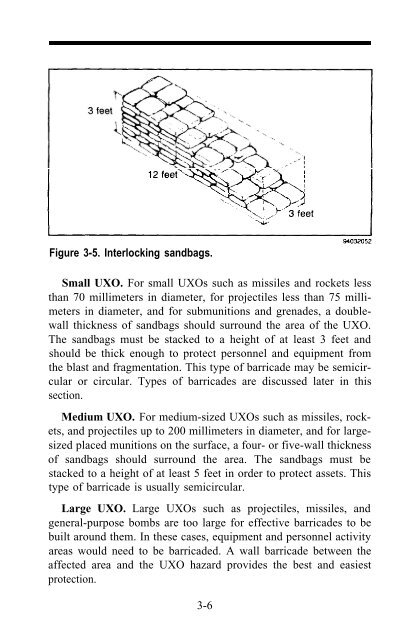FM 21-16 UXO Procedures
FM 21-16 UXO Procedures
FM 21-16 UXO Procedures
Create successful ePaper yourself
Turn your PDF publications into a flip-book with our unique Google optimized e-Paper software.
Figure 3-5. Interlocking sandbags.<br />
Small <strong>UXO</strong>. For small <strong>UXO</strong>s such as missiles and rockets less<br />
than 70 millimeters in diameter, for projectiles less than 75 millimeters<br />
in diameter, and for submunitions and grenades, a doublewall<br />
thickness of sandbags should surround the area of the <strong>UXO</strong>.<br />
The sandbags must be stacked to a height of at least 3 feet and<br />
should be thick enough to protect personnel and equipment from<br />
the blast and fragmentation. This type of barricade may be semicircular<br />
or circular. Types of barricades are discussed later in this<br />
section.<br />
Medium <strong>UXO</strong>. For medium-sized <strong>UXO</strong>s such as missiles, rockets,<br />
and projectiles up to 200 millimeters in diameter, and for largesized<br />
placed munitions on the surface, a four- or five-wall thickness<br />
of sandbags should surround the area. The sandbags must be<br />
stacked to a height of at least 5 feet in order to protect assets. This<br />
type of barricade is usually semicircular.<br />
Large <strong>UXO</strong>. Large <strong>UXO</strong>s such as projectiles, missiles, and<br />
general-purpose bombs are too large for effective barricades to be<br />
built around them. In these cases, equipment and personnel activity<br />
areas would need to be barricaded. A wall barricade between the<br />
affected area and the <strong>UXO</strong> hazard provides the best and easiest<br />
protection.<br />
3-6

















